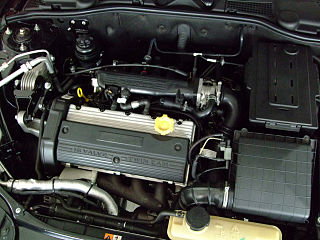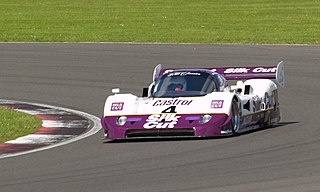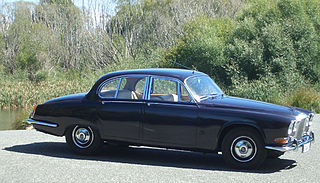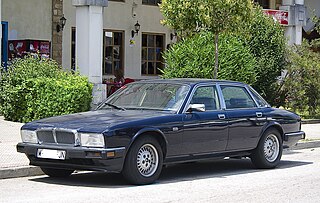AJ6
The original engines were the DOHC 3.6 and the SOHC 2.9. The DOHC 3.6 was revised and enlarged to 4.0 in 1990. It is still essentially an "AJ6", however. This was, as per usual, offered for the XJ-S before it was built into the XJ40 saloon.
3.6
The 3.6 L (3,590 cc) was the first AJ6 engine, debuting in 1983 on the XJ-S. It had DOHC 4-valve heads with a 91 mm × 92 mm (3.58 in × 3.62 in) bore and stroke. Power was 165 kW (224 PS; 221 hp) with 325 N⋅m (240 lb⋅ft) of torque. Power was reduced to 201 hp (150 kW; 204 PS) for versions having catalytic exhaust system. Early versions of the 3.6 L (3,590 cc) AJ6 as used in the 1984 - 1987 XJ-S cars had a conventional distributor type of ignition system with electronics within the distributor body. This early AJ6 ignition system is nearly identical to the system used on the XK engine in the Series III XJ6 cars. The Lucas fuel injection system on the 3.6 L (3,590 cc) AJ6 engines in these early XJ-S cars sensed engine load using a Manifold Absolute Pressure (MAP) sensor just like the V12 cars from the same era. Later 3.6 L (3,590 cc) AJ6 engines as used in the 1986–1989 XJ40 cars had a crank-sensor type of ignition system with a bare distributor that only carried the spinning ignition rotor inside the distributor cap. The fuel-injection system used on the later 3.6 L (3,590 cc) AJ6 engines used a hot-wire Mass Air Flow sensor to determine engine load.
Vehicles using the 3.6 were:
2.9
The 2.9 L (2,919 cc) used a SOHC head from the Jaguar V12 engine, and was prone to failure. The block is the same as the 3.6, with the crankshaft and pistons lowering the stroke to 74.8 mm (2.94 in). Only the 1986–1989 Jaguar XJ6 used the 2.9. It was used for the entry-level XJ6 in Britain and Europe but rarely, if ever, seen in models exported to the US. The SOHC 2.9, which was generally considered somewhat underpowered for such a large car, was discontinued in late 1990 and replaced with a DOHC 3.2 (essentially identical to the DOHC 4.0).
The 2.9 Engine was, as in earlier years the 2.8 XK-engine, sized to match road-tax regulations in some European Countries like Italy or France. In France cars with more than 3 litres of engine size had to pay a luxury tax.
Unlike all other AJ6's, the 2.9l used Bosch LH Jetronic fuel injection and EZ-K ignition (rather than Lucas 9 or 15CU EMS)
4.0 (1989–1994)
The 24-valve DOHC 4.0 L (3,980 cc) version replaced the 3.6 L (3,590 cc) AJ6 in 1989. It featured a longer 102 mm (4.02 in) stroke, and generated 183 kW (249 PS; 245 hp) power at 4,750 rpm and 392 N⋅m (289 lb⋅ft) of torque at 3,650 rpm. The 4.0 L (3,980 cc) engines as used in the 1990–1994 XJ40 cars continued with the crank sensor and empty distributor type of ignition system and the hot-wire Mass Air Flow sensor type of fuel injection control system as the 1988–1989 3.6 L (3,590 cc) XJ40 cars.
TWR modified XJ40s resulting in the XJR. Jaguarsport was also formed as a partnership between TWR and Jaguar. The first XJR, the XJR 3.6 L (3,590 cc), had extensive appearance changes coupled with stiffer suspension, anti-roll bar/links, power steering valve that reduced efficiency by 40% and an LSD but no performance enhancements. Interior-wise it included special stitching, "sport" or "XJR" embossed front headrests, and Jaguarsport speedometer labels and tread-plates.
1990 XJRs had the upgraded 3L engine with the old style body-kits, and appearance changers.
XJR 1.0Ls from 1990 on had all of the XJR 3.6 handling upgrades and benefits from engine enhancements such as high lift cams, improved double plenum inlet manifold, and a compression ratio of 9.75:1. They were sent to TWR in Coventry to be modified directly after being produced.
The exterior changed again for the last generation of the XJ40 XJR (from H-registration year onwards). Bodykit was re-sculptured and the boot spoiler was deleted. Side mouldings were added, with the smaller "XJR" badge embedded in them. Engine had a plaque saying "Jaguarsport XJR 4L" on the rocker cover. XJR badge size was decreased on the boot (had previously ranged from XJR-3.6, XJR-4L, 4-litre and "XJR". The later one ("XJR") is most common and the only badge that could be chosen on the boot infill panel models. A "sport" one on the front within its own unique XJR grill. In this unique grill a "sport" badge was installed. Interior even had XJR specific wood (SPB part number).
Total XJ40 cars built was 208,733 and supposedly 500 JaguarSport cars built, 200 of the round headlight versions and then about 300 with the square headlights like the Sovereigns and Daimler's. 1990+ XJR power output is around 250 bhp (186 kW; 253 PS) / 278 lb⋅ft (377 N⋅m).
3.2 (1990–1994)
A 24-valve DOHC 3.2 L (3,239 cc), essentially a shorter-stroke of 83 mm (3.27 in)4.0 L (3,980 cc), replaced the 12-valve SOHC 2.9 in 1990. It produced 149 kW (203 PS; 200 hp) of power at 5,250 rpm and 298 N⋅m (220 lb⋅ft) of torque at 4,000 rpm, and proved a popular engine in Europe (sales outnumbered 4.0 L (3,980 cc) saloons roughly 4:1) but was not exported to America.
Following the launch of the Aston Martin DB7, the Jaguar AJ6 was used by Aston Martin as well (both companies being owned by Ford at the time). This version featured an Eaton supercharger.
Cars using the 4.0 and 3.2 included:

A V12 engine is a twelve-cylinder piston engine where two banks of six cylinders are arranged in a V configuration around a common crankshaft. V12 engines are more common than V10 engines. However, they are less common than V8 engines.

Jaguar is the sports car and luxury vehicle brand of Jaguar Land Rover, a British multinational car manufacturer with its headquarters in Whitley, Coventry, England. Jaguar Cars was the company that was responsible for the production of Jaguar cars until its operations were fully merged with those of Land Rover to form Jaguar Land Rover on 1 January 2013.

The Rover K-series engine is a series of internal combustion engines built by Powertrain Ltd, a sister company of MG Rover. The engine was a straight-four cylinder built in two forms, SOHC and DOHC, ranging from 1.1 to 1.8 L; 67.9 to 109.6 cu in.

The Jaguar XJ is a series of mid-size/full-size luxury cars produced by British automobile manufacturer Jaguar Cars from 1968 to 2019. It was produced across five basic platform generations with various updated derivatives of each. From 1970, it was Jaguar's flagship four-door model. The original model was the last Jaguar saloon to have been designed under the leadership of Sir William Lyons, the company's founder, and the model has been featured in countless media and high-profile appearances.

The Jaguar AJ-8 is a compact DOHC V8 piston engine used in many Jaguar vehicles. It was the fourth new engine type in the history of the company. It was an in house design with work beginning before Ford's purchase of the company. In 1997 it replaced both designs previously available on Jaguar cars: the straight-6 Jaguar AJ6 engine, and the Jaguar V12 engine. It remained the only engine type available on Jaguar until 1999 with the launch of the S-Type, when the Jaguar AJ-V6 engine was added to the list. The AJ-V8 is available in displacements ranging from 3.2L to 5.0L, and a supercharged version is also produced. Ford Motor Company also used this engine in other cars, including the Lincoln LS and the 2002–2005 Ford Thunderbird, as well as in several Land Rovers, and the Aston Martin V8 Vantage.

The Jaguar XK is an inline 6-cylinder dual overhead camshaft (DOHC) engine produced by Jaguar Cars between 1949 and 1992. Introduced as a 3.4-litre, it earned fame on both the road and track, being produced in five displacements between 2.4 and 4.2-litres for Jaguar passenger cars, with other sizes being made by Jaguar and privateers for racing. A de-rated version was also used in certain military vehicles built by Alvis and Daimler.

An evolution of the 1964 DOHC prototype “XJ13” engine, the Jaguar V12 engine is a family of SOHC internal combustion V12 engines with a common block design, that were mass-produced by Jaguar Cars for a quarter of a century, from 1971 to 1997, mostly as 5.3‑litres, but later also as 6‑litres, and 7‑litre versions that were deployed in racing. Except for a few low-volume exotic sports car makers, Jaguar's V12 engine was the world's first V12 engine in mass-production. For 17 years, Jaguar was the only company in the world consistently producing luxury four-door saloons with a V12 engine. The V12 powered all three series of the original Jaguar XJ luxury saloons, as well as its second generation XJ40 and X305 successors.

The Jaguar XJ-S is a luxury grand tourer manufactured and marketed by British car manufacturer Jaguar Cars from 1975 to 1996, in coupé, fixed-profile and full convertible bodystyles. There were three distinct iterations, with a final production total of 115,413 units over 20 years and seven months.

In automotive engineering a multi-valve or multivalve engine is one where each cylinder has more than two valves. A multi-valve engine has better breathing and may be able to operate at higher revolutions per minute (RPM) than a two-valve engine, delivering more power.

The Mercedes-Benz R129 SL is a roadster which was produced by Mercedes-Benz from 1988 until 2001. The R129 replaced the R107 in 1989 and was in its turn replaced by the R230 SL-Class in 2002 for the 2003 model year.
Tom Walkinshaw Racing (TWR) was a motor racing team and engineering firm founded in 1976, in Kidlington, near Oxford, England, by touring car racer Tom Walkinshaw.

The Jaguar XJR-9 is a sports-prototype race car built by Jaguar for both FIA Group C and IMSA Camel GTP racing, debuting at the 1988 24 Hours of Daytona.

The Jaguar XJR-11 was a sports-prototype racing car introduced for the 1989 World Sports Prototype Championship, while its sister car the XJR-10 was introduced to compete in IMSA series races.

Daimler Sovereign was a name applied by British manufacturer Jaguar Cars to a sequence of luxury automobiles built by it but carrying the Daimler badge between 1966 and 1983.

The EN series engine is a four-cylinder, four-stroke engine used in kei cars sold by Subaru in Japan, succeeding the EK family of two-cylinder engines previously used in Subaru kei cars from 1958 to 1989. The EN family was introduced in 1989 and discontinued in 2012.

The Jaguar XJ (X350) is a full-size four-door luxury saloon car manufactured and marketed worldwide by Jaguar Cars for model years 2003–2009 as the third generation of the Jaguar XJ saloon, carrying the internal designation X350 and the internal designation X358 following its 2007 intermediate facelift. Both the X350 and X358 were available with a six-speed automatic transmission, a range of petrol and diesel engines, numerous trim levels, and short wheelbase (2003–2009) or long wheelbase (2005–2009) car body configurations. Extended-length models were the longest vehicles Jaguar had manufactured.

The Jaguar XJ (X300) is a full-size luxury saloon car manufactured by Jaguar Cars between 1994 and 1997. It was the first Jaguar XJ produced entirely under Ford Motor Company ownership, and can be considered an evolution of the outgoing XJ40 generation. Like all previous XJ generations, it features the Jaguar independent rear suspension arrangement. The design of the X300 placed emphasis on improved build quality, improved reliability, and a return to traditional Jaguar styling elements.

The Jaguar XJ (XJ40) is a full-size luxury sedan manufactured by Jaguar Cars between 1986 and 1994. It was officially unveiled on 8 October 1986 as an all-new, second generation of the XJ to replace the Series III, although the two model ranges were sold concurrently until the Series III was discontinued in 1992. The XJ40 used the Jaguar independent rear suspension arrangement, and featured a number of technological enhancements, such as electronic instrument cluster.

The Jaguar XJ (X308) is a full-size luxury saloon car manufactured and marketed by Jaguar Cars for years 1997–2003 across two generations and featuring the Jaguar AJ-V8 engine and Jaguar independent rear suspension. It was the third and final evolution of the Jaguar XJ40 platform that had been in production since 1986. It was preceded by the Jaguar XJ (X300).


















